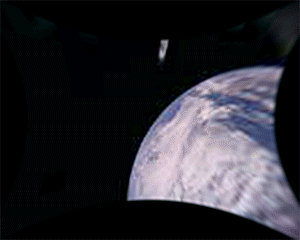
This is a version of the TIME Space newsletter that went out July 26, 2019.
Dear readers,
Jeff Kluger is out this week. I’m Alejandro de la Garza, a researcher and reporter at TIME, and a writer on all things technology.
Humanity might have gotten a tiny bit closer to interstellar travel this week, with a very, very small satellite.
That satellite, dubbed LightSail 2 by its creators at the nonprofit Planetary Society, started off as a box about the size of a loaf of bread. And on July 23, the little-cube-that-could deployed a 344 sq. ft. sheet of thin, reflective mylar, becoming the first steerable solar sail ever launched into Earth’s orbit.

Solar sails, for those who don’t know, sound a bit crazy—but also may be just crazy enough to work. Most rockets burn their onboard fuel to accelerate in space and then coast on their built-up momentum. Solar sails, on the other hand, are powered by photons emitted by the sun. They accelerate very slowly, but since their thrust is continuous, they can conceivably achieve tremendous speeds.
LightSail 2 isn’t the first solar sail. In 2010, JAXA, Japan’s space agency deployed a non-steerable solar sail that traveled past Venus, and in 2015 the Planetary Society launched LightSail 1, which deployed its sail, but was orbiting too low to overcome the resistance of Earth’s atmosphere. That test mission ended with a fiery return to Earth.
Solar-sail technology may hold great promise. Early in the next decade, NASA plans to launch the Near-Earth Asteroid Scout, a solar sail intended to visit an asteroid. And in 2016, a private group led by Israeli-Russian philanthropist Yuri Milner announced a plan to use lasers to rapidly accelerate a swarm of tiny reflective spacecraft to 20% the speed of light. The probes would then coast to Alpha Centauri, more than four light years away.
That dream, like most ideas that involve slipping the bounds of our solar neighborhood, might be more than a little starry-eyed. But then again, so was the idea of using solar sails at all when Carl Sagan, a co-founder of the Planetary Society, demonstrated one on The Tonight Show more than four decades ago. When it comes to space travel, a bit of crazy dreaming is often the first step in getting off the ground.
—Alejandro
PHOTO OF THE WEEK

The evening of July 25, SpaceX’s CR-18 mission successfully launched from Cape Canaveral Air Force Station, Florida. It’s a resupply flight to the International Space Station, and will carry with it, among other things, a bag of Nickelodeon Slime, which any child of the 1990’s (or parent of a child of the 1990’s) will remember well. The project, according to the ISS National Lab website, “aims to develop educational videos and other digital content on slime experiments in space.”

Images courtesy ISS National Lab.
WHAT WE’RE READING
What if the solution to climate change is hiding in space? Writing for Foreign Policy, Greg Autry, the director of the Southern California Commercial Spaceflight Initiative at the University of Southern California, makes a compelling case for the necessity of space research in solving Earth’s climate crisis. He invites us to imagine, for example, space-based solar-power stations that would overcome the currently unsolvable conundrum that today’s renewable energy sources are inherently intermittent.
India’s big step towards the moon. The country successfully launched its Chandrayaan-2 spacecraft and deployed it into Earth orbit. The mission means a ton to India: if successful, it would make India just the fourth nation to land on the moon. It also means a lot to human space exploration more generally: the mission’s Pragyan rover will be the first to directly survey the moon’s south pole, where scientists believe the moon’s motherload of water ice is located.
Let’s go places. Toyota, the world’s biggest car manufacturer, unveiled a concept manned lunar rover it’s working on with JAXA, the Japanese space agency. They also laid out a timeline, and it’s pretty ambitious, with a full-size prototype targeted for 2022. The ultimate goal is to have it ready for a manned lunar mission in 2030.
In memoriam: Chris Kraft. This past week, one of the lions of NASA’s golden era passed away at the age of 95. Regular TIME Space writer Jeff Kluger wrote a lovely appreciation of Kraft, the “conductor” of the Apollo missions of the 1960s and ‘70s, who was brilliant and did not suffer fools easily. For a little taste, here’s an anecdote Jeff tells about meeting Kraft in the 1990s:
He described someone he had once worked with at NASA as “a dumbass.” I asked him what he meant specifically by that term. He looked at me wonderingly and said, “I mean stupid! Not intelligent!”
NUMBER OF THE WEEK
$1,820,000
Winning bid for three reels of original, first-generation NASA videotape recordings of the 1969 Apollo 11 moon landing. According to Sotheby’s, the auction house that sold the tapes, they are in immaculate condition, having only been viewed three times since 1976.
The previous owner was Gary George, who bought them at a government surplus auction in 1973. George paid $217.77 for a lot of about 1,150 reels of magnetic tape, not knowing that the moon landing recordings were among them.
THANKS FOR READING
TIME Space is usually written by Jeffrey Kluger. This week, Alejandro de la Garza and Elijah Wolfson pinch hit for Jeff. We welcome any feedback at space@time.com.
More Must-Reads from TIME
- Inside Elon Musk’s War on Washington
- Meet the 2025 Women of the Year
- Why Do More Young Adults Have Cancer?
- Colman Domingo Leads With Radical Love
- 11 New Books to Read in Februar
- How to Get Better at Doing Things Alone
- Cecily Strong on Goober the Clown
- Column: The Rise of America’s Broligarchy
Write to Alejandro de la Garza at alejandro.delagarza@time.com